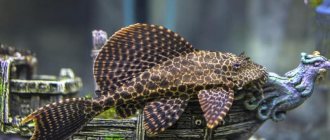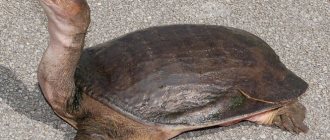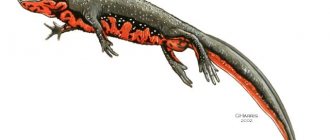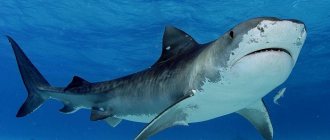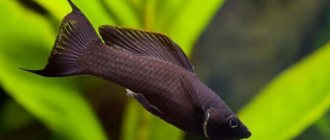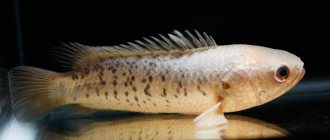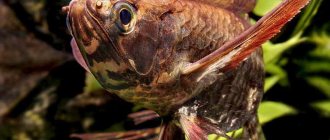5
(3)
The large and slightly shy Chukuchan on the aquarium market may be called frigate fish, myxocyprin, Asian or humpback Chukuchan, but the most common name is Chinese sailfish. Among aquarists it is considered an exotic fish.
This non-aggressive big guy grows up to 50cm and is kept in a flock. Therefore, not everyone can take care of this fish. In some European countries, the import of this species is prohibited, but this fact only fuels the interest of amateurs.
Habitat in nature
The Chinese Chukuchang is endemic to the Yangtze River and its main tributaries. Its habitat is under threat, as the area is being actively developed, the river is being polluted, and invasive species, such as carp, have appeared among the inhabitants.
Listed in the Chinese Red Book as a threatened species, it has completely disappeared in the Yangtze tributary, the Ming River.
Pelagic species, predominantly inhabiting the main course of the river and large tributaries. Juveniles stay in places with weak currents and rocky bottoms, while adult fish go deeper.
Compatibility with other fish
Large in size, Myxocyprinus asiaticus is a shy, non-aggressive species with a gentle character. Small fish can become an accidental victim of the Chukuchan, so such proximity is not recommended.
Active cichlids or barbs will gnaw the long fins of the Chinese sailfish, so this cohabitation should be avoided.
It gets along well with similar-sized adult swordtails, marbled and pearl gouramis, large rainbows, sailing mollies, corydoras and ancistrus.
Keeping in an aquarium
Cold-water fish that requires large quantities. For keeping, you need a spacious aquarium with cold water, since they need to be kept in schools, and each fish can grow to a minimum of 40 cm.
This means that 1500 liters is not too much volume for Chukuchans; a more spacious aquarium is better. Do not buy these fish if you have no place to keep them in the future!
In nature, sailfish live in water whose temperature ranges from 15 to 26°C, although prolonged keeping at temperatures above 20°C is not recommended. The recommended water temperature is 15.5 – 21 °C, since at higher temperatures the development of fungal diseases is observed.
The decor is not as important as the quality of the water and the abundance of free space for swimming. You need to decorate the aquarium in the style of a river - with large round boulders, small pebbles and gravel, and large driftwood.
Like all fish that naturally live in fast rivers, they cannot tolerate water with a high ammonia content and low oxygen content. You also need a strong current, a powerful external filter is a must.
Description
There are 3-4 very wide transverse stripes of dark color running along the light beige body. The fins are also dark. A very expressive dorsal fin – large, sail-shaped.
With a slightly lowered mouth and large sad eyes, it resembles a panda or a bear cub. The habits are also similar - although the fish are agile, they are clumsy; the pectoral fins seem to “cling” when moving. In young individuals, the dorsal fin is very high and the ridge is raised. As it grows, the body elongates and the fin descends.
Able to change color depending on mood. Females are larger than males.
In natural conditions, the size of the sailfish can reach 80 - 90 cm and weight up to 40 kg; in aquariums it does not grow more than 20-25 cm.
Fishing
From a fish farming point of view, an important feature of Chukuchan is its great resistance to unfavorable environmental conditions. Our experiments have shown that producers tolerate catching with fixed nets, keeping in cages, transportation and sorting well. Abundant mucus on the surface of the body also contributes to increased survival: at an air temperature of +15°C (in the shade), the Chukuchans were out of water for up to 3 hours without any damage; released into the cage after the experiment, they continued to live. As for the pH indicator, its negative effect on eggs and juveniles is only felt at a value below 5.2. There are known cases when Chukuchans were found in brackish water - in places where rivers flow into the ocean.
Unusual body structure and other characteristics
First of all, this is a special gutter, which is located on the back. The sailboat retracts its large main fin into it when moving quickly, and instantly straightens it during sharp turns and other maneuvers. At the same time, the visual size of the individual increases 3 times.
Sometimes you can observe the unfolded fin of a sailfish at rest above the surface of the water.
The jaws also have a unique structure, reminiscent of the jaws of a pipefish. Externally imitating a pike, they have an impressive length and create turbulent flows when moving. Moving even at low speed, the predator easily overcomes the resistance of water.
The main distinguishing feature of the fish is the huge first dorsal fin, due to which the sailfish got its name
To accelerate in the water column, the fish mainly uses the tail muscles, while the amplitude of the tail movement has a small range, but a significant frequency. The caudal fin is represented by two narrow stripes that have a steep, almost perpendicular slope in relation to the body. With this principle of tail movement and fin structure, maximum speed is achieved.
The sailfish does not have a swim bladder. This means that the fish has negative buoyancy, meaning it does not have to overcome additional resistance.
So, the factors that allow the sailboat to take first place in speed among fish:
- unique body structure;
- peculiarity of the jaws and turbulence;
- notch for closed dorsal fin;
- absence of a swim bladder.
There is an interesting opinion from scientists about the large fin on the back of this fast-moving vessel. It contains a significant number of tiny blood vessels, and swimming at high speeds warms up the fish's blood. Therefore, in order to cool it down, the giant jumps to the surface at full speed, straightening its fin.
Economic importance
In general, Chukuchan fish meat is rightfully considered a low-calorie product, therefore ideal for a diet menu. The vitamin and mineral composition of fish of this species deserves special attention. it contains a high content of vitamin groups A, B and, of course, PP. In addition, the chemical composition of fish is enriched with compounds valuable for the human body, among which the most famous are potassium, phosphorus, zinc, magnesium, manganese and calcium.
The economic importance of the Chukuchan in our country is still small. This is mainly due to the underestimation of Chukuchan as a food product. According to V.I. Veselov, the calorie content of its meat is higher than that of vendace, pike, roach, crucian carp and perch. In this respect, it is second only to peled.
In terms of the weight composition of edible and inedible body parts, the Chukuchan also has an advantage over other fish, in particular pike, burbot and muksun.
There is no data on artificial breeding of the Chukuchan yet. Experimental work carried out in the ponds of the Central Electric Power Plant "Ropsha" in 1978 showed that the waste of eggs during the incubation period does not exceed 3%.
Larvae about 7 days old were transplanted into a nursery pond with an area of 4 hectares and an average depth of 1.2 m. During the lot, the water temperature ranged from 15.7 to 22.4°. In October, at the age of 3 months, fingerlings weighed from 1.5 to 2.5 g. One and a half months old fry switch to feeding on benthic organisms and filamentous algae, which account for 80% of the mass of all food. By the age of three months, benthos becomes the main food of the Chukuchan, with up to 60% being detritus.
The positive qualities of Chukuchan allow us to recommend it for artificial breeding in lakes and reservoirs. If it matures and spawns in new conditions, it can become a promising object for acclimatization.
Sources: vkusnoblog.net , fito-center.ru , dic.academic.ru
Similar articles:
Fishing in Yakutia
According to the latest data, on the territory of Yakutia alone there are more than 450 thousand rivers and streams with a total length of over 1.5 million kilometers. According to Yakutrybvid, the fishery fund includes 9,053 rivers with a total length of 28.1 thousand kilometers, which is 2% of the total river fund. The rivers of greatest importance for fisheries are: Lena, Kolyma, Indigirka, Yana, Olenek, Anabar and their large tributaries Aldan, Vilyui, Myankyare, Omolon and others. The fishery fund does not include water areas of reserves allocated in river deltas, as well as hard-to-reach rivers,…
Taimen
Taimen (Yakut. Beel, tiisteekh (Olekma), Young taimen - Tiisteekh uola (Olekma)) is a genus of large salmon fish. Small specimens have 8-10 dark transverse stripes on the sides of the body, and small x-shaped and semilunar dark spots are common. During spawning, the body is copper-red. Widely distributed in almost all large rivers and lakes of Siberia and the Far East, also in Altai, for example: in the Bukhtarma and Kurchum rivers. Like other salmon, taimen is a predator, reaching 1 m or more in length and 60 kg in weight. It is reported that in 1943, a taimen weighing 105 kg was caught in a net on Kotui and...
Red Book of the Republic of Sakha (Yakutia). Fish
1. The Red Book of the Republic of Sakha (Yakutia) is considered an official state document containing a set of information about disappeared, endangered, vulnerable, rare and small species, subspecies and populations of animals, plants and fungi of Yakutia, as well as the necessary measures for their protection and restoration. 2. Objects of flora and fauna, mushrooms listed in the Red Book of the Republic of Sakha (Yakutia) are subject to state protection.3. Removal from the natural environment of subjects of the animal and plant world, mushrooms,…
How Russian Arctic old-timers prepare stroganina
It seems that preparing stroganina is as easy as shelling pears. In fact, this is great art, which has many of its own characteristics. The famous Yakut writer and local historian Alexei Chikachev has spoken more than once about how Russian Arctic old-timers have been preparing it from time immemorial. We present to you the “recipe” for making stroganina, prepared on the basis of archival materials by Alexey Gavrilovich...
Asian smelt
Asian smelt, or American smelt (Yakut. Timir atah). Smelt is a migratory fish and has freshwater lake subspecies. Widespread and highly populated...
Breeding
The ability to reproduce appears at the age of six years. In their natural environment, sexually mature chukuchans migrate for a long time to the upper reaches of rivers at the end of winter or early spring to lay eggs, and return back in the fall.
In aquariums, given the size of six-year-old sailfish, it is not possible to recreate such conditions. Therefore, juveniles are bred on specialized farms using hormones.
ACARA PORTO ALEGRE: DESCRIPTION, PHOTO, CARE, BREEDING
BLUE DEMPSY: DESCRIPTION, CARE, PHOTO, FEEDING, CONTENTS
Cornflower blue haplochromis: DESCRIPTION, CONTENTS, BREEDING, COMPATIBILITY, PHOTO, VIDEO.
Lifestyle of sailfish
This type of fish likes to live in warm waters. During the cold season in temperate latitudes, fish migrate to warmer waters, and with the arrival of warmth in temperate zones, they return back again. The sailfish hunts not alone, but in a group. Sailboats attack schools of fish suddenly, their speed gives them this opportunity. With their spikes on their heads, they injure small fish, and thanks to their speed, they quickly tire and overtake larger prey.
As mentioned above, the sailfish swims very quickly. During such fast swimming, the fish's sail hides in a special recess. The remaining long fins are also hidden. The sail and fins help the fish slow down and change direction.
Nutrition
It has a lower mouth adapted for collecting food from the bottom. In nature, the basis of nutrition is detritus. The aquarium accepts all food, but the correct ratio should be 60% live food and 40% plant food. The latter helps to preserve the intense coloring of the fish.
Among live foods, preference is given to corret, tubifex, bloodworms and shrimp. Among the plant species, they readily eat pears, cucumbers and melon peels. Dry food is fed exclusively for the purpose of diversifying the diet. This can be flakes, tablets or granules, as well as specialized food for ornamental carp species. Requires abundant feeding.
White Chukuchan or Meunier Noir
One of the interesting fish of Quebec is the White Chukuchang . His official name in French is Meunier Noir , in English - White Sucker . It is also known as " Carpe à cochon ", i.e. carp-pig. Latin name - Catostomus commersonii .
The white Chukuchan belongs to the genus “ Chukuchans ” (Catostomus) from the family “ Chukuchans ” (Catostomidae). He is originally from North America. This fish is found throughout Canada, from Newfoundland and Labrador to British Columbia, as well as in the Yukon and Northwest Territories and throughout the Great Lakes. In Quebec, it is widespread in the south. In northern Quebec - only up to Fort Chimo, and absent in Gaspésie.
The White Chukuchan feeds on worms, mollusks, insect larvae, plant material, and sometimes the eggs of other fish.
In turn, white chukuchans serve as food for pike, muskie, bass, pike perch, burbot, trout and a variety of birds and mammals.
Chukuchanovs are similar in appearance to cyprinids. Therefore, they believe that they originate from them. Unlike ordinary carp, these fish never have antennae, there is no millstone, and the body is always covered with clearly visible scales.
Its color can vary from gray to almost black, including brown and bronze. I have seen juveniles that are light in color, but the larger ones are darker in color. Most likely, this is why in the French name it is “black”, and in Russian and English it is “white”.
The white Chukuchan has an elongated, spindle-shaped body. The mouth is round with thick lips, with a characteristic downward slope, a bit like a sturgeon.
Spawning occurs in spring at a water temperature of about 10 °C. Females can lay 20,000 to 50,000 eggs. On average, the white Chukuchan grows to 38-50 centimeters in length and gains 1.5-2 kg of weight.
Nutritional value and benefits:
The White Chukuchang is highly underrated as a food fish. It has many small bones, but its meat is dense, with a sweet aroma and taste.
Fishing technique:
White Chukuchan is caught on a donk or feeder. It can also be caught on small spoons and spinners, as well as fly flies and streamers.
You can use worms, carp boilies, larvae and insects as bait for the bottom.
Catch limit:
The white chukuchang is not included in the main fishing bans in zone 8, but in many places it is prohibited to take it.
Fishing is prohibited in the Rivière des Milles Îles from the Lake of the Two Mountains to its confluence with the St. Lawrence River. In Rivière-des-Prairies, the ban extends from the Hydro-Quebec dam, near the Pie-IX bridge, to where it flows into the St. Lawrence River. If you catch such a beauty, immediately release him back into the water.
In the St. Lawrence River (as in Lake Saint-Pierre), the ban applies between the outlet side of the Beauharnois and Pointe-des-Cascade dams and the outlet side of the Hydro-Quebec hydroelectric dam at Tracy.
As far as I understand, it can be caught in the Lake of the Two Mountains and in the Oka National Park, in the parks on Ile Bizard, as well as in the part of the Rivière des Prairies that reaches the Hydro-Quebec dam near the Pie-IX bridge.
In other places, you need to carefully check whether this fish can be taken or not. So, if you don’t know for sure, then it’s better not to take this fish, as you may face a fine.
Summary: White chukuchans can be caught on your bottom in many places, but it is better to release this fish back into the water if you are fishing in an unfamiliar place. In zone 8, you can specifically hunt for him only in carefully selected places. Things may be different in other areas, so if you want to go specifically for these fish, do your research on the areas you plan to go to.
